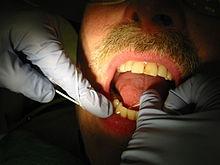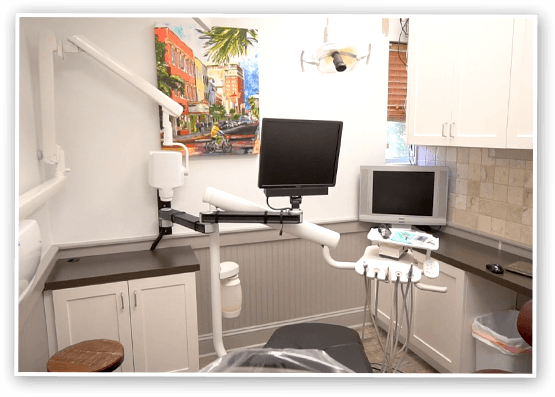Teeth cleaning is the removal of dental plaque and tarter rom teeth to prevent cavities, gingivitis, and gum disease. Severe gum disease causes at least one-third of adult tooth loss.

Tooth decay is the most common global disease, affecting every family. Over 80% of cavities occur inside pits and fissures on chewing surfaces where brushing cannot reach. Food is left trapped after every meal or snack, and saliva or fluoride have no access to neutralize acid and remineralizer a demineralized tooth.
Dentists apply sealants over grooves in the chewing surfaces of back teeth, preventing food from being trapped and halting the decay process. An elastomer strip has been shown to force sealants deeper inside opposing chewing surfaces at the same time and can also force fluoride toothpaste inside chewing surfaces before brushing to re-mineralize demineralized teeth.
Since before recorded history, a variety of oral hygiene measures have been used for teeth cleaning. This has been verified by various excavations done all over the world, in which chew sticks, tree twigs, bird feathers, animal bones and porcupine quills were recovered. Many people used different forms of teeth cleaning tools. Indian medicine (Ayurveda) has used the neem tree (a.k.a. daatun) and its products to create teeth cleaning twigs and similar products for millennia. A person chews one end of the neem twig until it somewhat resembles the bristles of a toothbrush, and then uses it to brush the teeth. Rubbing baking soda or chalk against the teeth was also common.
Generally, dentists recommend that teeth be cleaned professionally at least twice per year. Professional cleaning includes tooth scaling, tooth polishing, and, if too much tartar has built up, debridement. This is usually followed by a fluoride treatment.
Between cleanings by a dental hygienist, good oral hygiene is essential for preventing tartar build-up which causes the problems mentioned above. This is done by carefully and frequently brushing with a toothbrush and the use of dental floss to prevent accumulation of plaque on the teeth.
Plaque
Plaque is a sticky film that forms on the teeth and gums. The bacteria in plaque release acid that attacks tooth enamel. Tooth decay can occur after repeated attacks. Some food causes plaque bacteria that produce acids. Thorough daily brushing and flossing can prevent tartar from forming on the teeth.
Plaque can also cause irritation to the gums, making them red, tender, or bleed easily. In some cases, the gums pull away from the teeth, leaving cavities inhabited by bacteria and pus. If this is not treated, bones around the teeth can be destroyed. Teeth may become loose or have to be removed as with periodontal (gum) disease in mostly adults. Eating a balanced diet and limiting snacks can prevent tooth decay and periodontal disease. Nutritious foods such as raw vegetables, plain yogurt, cheese, or a piece of fruit are considered good snack foods to grab.
Flossing
The use of dental floss is an important element of oral hygiene, since it removes the plaque and the decaying food remaining stuck between the teeth. This food decay and plaque cause irritation to the gums, allowing the gum tissue to bleed more easily. Acid-forming foods left on teeth also demineralize teeth, eventually causing cavities. Flossing for a proper inter-dental cleaning is recommended at least once per day, preferably before bedtime, to help prevent receding gums, gum disease, and cavities between the teeth.
- Use enough floss to be able to wrap it around your two middle fingers leaving an inch or two of floss between.
- Holding the floss tightly, gently move the floss up and down between teeth.
- Go beneath the gum line by curving the floss around each tooth.
- Use a clean section of the floss when moving from tooth to tooth.
- To remove floss, use the same back and forth motion to gently bring the floss away from teeth.
Tongue Cleaning
Cleaning the tongue as part of the daily oral hygiene is essential, since it removes the white/yellow bad-breath-generating coating of bacteria, decaying food particles, fungi (such as Candida), and dead cells from the dorsal area of tongue. Tongue cleaning also removes some of the bacteria species which generate tooth decay and gum problems.
Gum Care
Massaging gums with toothbrush bristles is generally recommended for good oral health. Flossing is recommended at least once per day, preferably before bed, to help prevent receding gums, gum disease, and cavities between the teeth.
Oral Irrigation
Dental professionals usually recommend oral irrigation as a great way to clean teeth and gums.
Oral irrigators can reach 3–4 mm under the gum line, farther than toothbrushes and floss. And the jet stream is strong enough to remove all plaque and tartar. The procedure leaves a feeling of cleanliness and freshness, and disrupts more plaque or bacteria than floss since it cleans deeper.
Food Drink
Foods that help muscles and bones also help teeth and gums. Breads and cereals are rich in Vitamin B, while fruits and vegetables contain Vitamin C, both of which contribute to healthy gum tissue. Lean meat, fish, and poultry provide magnesium and zinc for teeth. Some people recommend that teeth be brushed after every meal and at bedtime, and flossed at least once per day, preferably at night before sleep. For some people, flossing might be recommended after every meal.
Beneficial foods
Some foods may protect against cavities. Fluoride is a primary protector against dental cavities. Fluoride makes the surface of teeth more resistant to acids during the process of remineralization. Drinking fluoridated water is recommended by some dental professionals, while others say that using toothpaste alone is enough. Milk and cheese are also rich in calcium and phosphate, and may also encourage remineralization. All foods increase saliva production, and since saliva contains buffer chemicals, this helps to stabilize the pH to near 7 (neutral) in the mouth. Foods high in fiber may also help to increase the flow of saliva. Sugar-free chewing gum stimulates saliva production and helps to clean the surface of the teeth.
Dietary and salivary iodine seems also important in oral heath prevention. The trophic, antioxidant, and apoptosis-inductor actions and the presumed anti-tumor activity of iodide might also be important for prevention of oral and salivary glands diseases.
According to World Dental, these are the top ten beneficial foods for teeth:
- Green tea contains polyphenol antioxidant plant compounds, which are thought to reduce plaque and to help reduce cavities and gum disease. Tea may also help reduce bad breath. Tooth enamel can be strengthened because green tea contains fluoride, which promotes healthy teeth.
- Milk and yogurt are good for teeth because they contain low acidity, which means that wearing of teeth is less. They are also low in decay-inducing sugar. Milk is a good source of calcium, the main component of teeth and bones.
- Cheese contains calcium and phosphate, which helps balance pH in the mouth, preserves (and rebuilds) tooth enamel, produces saliva, and kills bacteria that cause cavities and disease.
- Fruits such as apples, strawberries and kiwis contain vitamin C. This vitamin is considered the element that holds cells together. If this vitamin is neglected, gum cells can break down, making gums tender and susceptible to disease.
- Vegetables: Vitamin A, found in pumpkins, carrots, sweet potatoes, and broccoli, is necessary for the formation of tooth enamel. Crunchy vegetables may also help clean gums.
- Onions contain antibacterial sulfur compounds. Tests show that onions kill various types of bacteria, especially when eaten raw.
- Celery protects teeth by producing saliva, which neutralizes bacteria that cause cavities. It also massages the teeth and gums.
- Sesame seeds reduce plaque and help build tooth enamel. They are also very high in calcium.
- Animal food: beef, chicken, turkey, and eggs contain phosphorus which, with calcium, is one of the two most vital minerals of teeth and bone.
- Water cleans the mouth and produces saliva that deposits essential minerals into the teeth. It keeps teeth hydrated and washes away particles from the teeth.
Detrimental Foods
Sugars are commonly associated with dental cavities. Other carbohydrates, especially cooked starches, e.g. crisps/potato chips, may also damage teeth, although to a lesser degree since starch has to be converted by enzymes in saliva first.
Sucrose (table sugar) is most commonly associated with cavities. The amount of sugar consumed at any one time is less important than how often food and drinks that contain sugar are consumed. The more frequently sugars are consumed, the greater the time during which the tooth is exposed to low pH levels, at which point demineralization occurs (below 5.5 for most people). It is important, therefore, to try to encourage infrequent consumption of food and drinks containing sugar so that teeth have a chance to be repaired by remineralization and fluoride. Limiting sugar-containing foods and drinks to meal times is one way to reduce the incidence of cavities. Sugars from fruit and fruit juices, e.g., glucose, fructose, and maltose seem equally likely to cause cavities.
Acids contained in fruit juice, vinegar, and soft drinks lower the pH level of the oral cavity, which causes the enamel to demineralize. Drinking drinks such as orange juice or cola throughout the day raises the risk of dental cavities tremendously.
Another factor which affects the risk of developing cavities is the stickiness of foods. Some foods or sweets may stick to the teeth and so reduce the pH in the mouth for an extended time, particularly if they are sugary. It is important that teeth be cleaned at least twice a day, preferably with a toothbrush and fluoride toothpaste, to remove any food sticking to the teeth. Regular brushing and the use of dental floss also removes the dental plaque coating the tooth surface.
Chewing gum assists oral irrigation between and around the teeth, cleaning and removing particles, but for teeth in poor condition it may damage or remove loose fillings as well.
Other
Smoking and chewing tobacco are both strongly linked with multiple dental diseases. Regular vomiting, as seen in bulimia nervosa, also causes significant damage.
Mouthwash or mouth rinse improves oral hygiene. Dental chewing gums claim to improve dental health.
Retainers can be cleaned in mouthwash or denture-cleaning fluid. Dental braces may be recommended by a dentist for best oral hygiene and health. Dentures, retainers, and other appliances must be kept extremely clean. This includes regular brushing and may include soaking them in a cleansing solution.
We invite you to visit the following pages to learn more about our general and family dentistry in Goose Creek, South Carolina:
Please contact our office at 843-764-3081 today if you would like to schedule a visit with Dr. Gilreath and associates, our dentists at Goose Creek Family Dentistry.
Dental Hygiene
A dental hygienist is a licensed dental professional who specializes in preventive oral health, typically focusing on techniques in oral hygiene. Local dental regulations determine the scope of practice of dental hygienists. In most jurisdictions, hygienists work for a dentist, and some are licensed to administer local anesthesia. Common procedures performed by hygienists include cleanings known as prophylaxis, scaling and root planing for patients with periodontal disease, taking of prescribed radiographs, dental sealants, administration of fluoride, and providing instructions for proper oral hygiene and care.
The dental hygiene process of care has five steps:
- Assessing the patient: This includes, but is not limited to, a full review of the patient’s medical history, necessary X-rays to be taken, a clinical exam, and a periodontal assessment by probing areas of the patient’s mouth. A dental hygienist must have great finger dexterity.
- Dental hygiene diagnosis: Assessing of data pertaining to a client’s condition in terms that will help identify problems so as to lead to a creation of an order to apply available professional therapies. The diagnosis of disease in most jurisdictions may only be performed by the doctor.
- Planning: Creating a sequential treatment plan for the patient. The treatment plan will vary based on the patient’s immediate needs.
- Implementation: Carrying out the plan.
- Evaluation: Determining the effectiveness of the work that was performed.
If you struggle with dental anxiety, please let us know before your appointment. We provide IV sedation to help you relax during your visit and a member of our team will be happy to tell you more.
To learn how our team at Goose Creek Family Dentistry can help you improve your dental hygiene in Goose Creek, South Carolina, call 843-764-3081 today. We will gladly answer any questions you have and help you arrange an appointment with our dentists, Dr. Gilreath and associates.





